
* The French Dassault Mirage III and 5 delta-winged fighters were excellent aircraft and were built in large numbers, but their delta-wing configuration gave them almost inherent limitations, such as a long take-off run and limited agility. In the late 1960s, the Dassault company decided to follow the Mirage III/5 with a new technology fighter of more conventional configuration, the "Mirage F1", which proved successful, though not to the extent enjoyed by its delta-winged predecessors. This document provides a history and description of the Mirage F1.
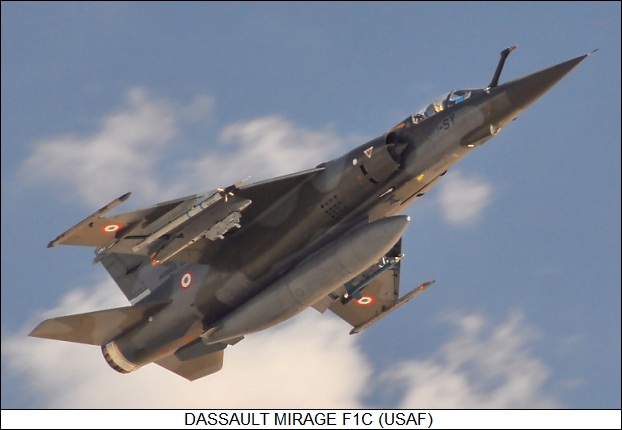
* In the early 1960s, the French air force, the Armee de l'Air (AA), was casting about for a successor to the Dassault Mirage III delta-winged fighter, envisioning both a high-speed interceptor and a low-level tactical strike aircraft, or possibly one that could do both jobs.
The result was a confusing flurry of prototype construction by the Dassault firm, including a "Mirage IIIT" delta-winged fighter with a new, substantially uprated bypass turbojet engine; the "Mirage IIIV" vertical take-off fighter, a Mirage III delta-wing derivative with no less than eight Rolls-Royce liftjets straddling a bypass turbojet engine; and the "Mirage G8" variable geometry fighter, with a fuselage something like that of a scaled-up Mirage III, but conventional swept tail surfaces and a high-mounted "swing wing".
None of these designs went to production. The Mirage IIIV would take the starring role in something of a fiasco, detailed in the companion document on the Mirage III/5 series. The AA had great hopes for the Mirage G8, but the program was axed in the mid-1970s due to cost escalation and a suspicion, with some basis in fact, that variable geometry was oversold.
Although the AA had focused on the Mirage G8, the service had also hedged bets on a simpler solution, the "Mirage F2" (originally "Mirage IIIF2"), which was essentially the G8 without a swing wing, instead featuring a high-mounted swept wing with high-lift devices. Initial flight was on 12 June 1966, with Jean Coreau at the controls. The Mirage F2 was something of the French answer to the British BAC TSR.2, then in development, but not quite as leading-edge. It was powered by a US-built P&W TF30 afterburning low bypass fan jet, providing 82.4 kN (8,400 kgp / 18,520 lbf) afterburning thrust.
___________________________________________________________________
DASSAULT MIRAGE F2:
___________________________________________________________________
wingspan:
10.5 meters (34 feet 6 inches)
wing area:
36 sq_meters (387.5 sq_feet)
length:
17.6 meters (57 feet 9 inches)
height:
5.8 meters (19 feet)
empty weight:
9,500 kilograms (20,945 pounds)
MTO weight:
18,000 kilograms (39,685 pounds)
max speed at altitude:
2,350 KPH (1,460 MPH / 1,270 KT)
service ceiling:
15,240 meters (50,000 feet)
combat radius (lo-lo):
555 kilometers (345 MI / 300 NMI)
___________________________________________________________________
Production machines were to be powered by an improved SNECMA-built variant of the TF30, the TF306. The prototype was refitted with the TF306, providing an afterburning thrust of 88.3 kN (9,000 kgp / 19,845 lbf), later in 1966, with the aircraft soon breaking Mach 2 in level flight.
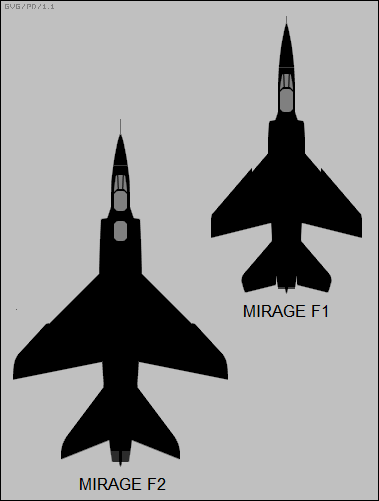
Dassault was hedging bets of their own as well, designing a somewhat scaled-down interceptor version of the F2, the "Mirage F3", and a lightweight multirole version, the "Mirage F1". Dassault funded construction of an initial F1 prototype, which performed its first flight on 23 December 1966 with Rene Bigand at the controls. It broke Mach 2 in early January 1967.
By that time, AA brass had decided that the service had plenty of strike aircraft and no need for the F2, but there was an outstanding need for an interceptor. On the face of it, the Mirage F3 might have been thought to be the appropriate solution, but in February the decision was made to obtain a hundred F1s, with the matter formalized in March and then announced in late May at the Paris Air Show. Unfortunately, Dassault was unable to show off the F1 prototype at the airshow, since it had broken up in flight due to flutter on 18 May, Bigand being killed. The tragedy did not delay the program much, with a contract for three F1 preproduction machines awarded in September.
Exactly why the AA ended up acquiring the F1 instead of the F3 remains unclear -- it may have had a more attractive pricetag, but it also may have been a recognition in government circles that the multirole F1 had greater flexibility and export potential than the dedicated interceptor F3. In any case, although an F3 prototype had been under construction, it was abandoned in 1967.
The first of the three preproduction machines, marked "Super Mirage F1", performed its initial flight on 20 March 1968, with Jean-Marie Saget at the controls. The second took to the air on 18 September 1969, with the third following on 17 June 1970. The first preproduction machine now resides in the Musee de l'Air at Le Bourget.
The AA placed a production order for the "Mirage F1C" interceptor variant in 1969, the "C" standing for "chasse (fighter)". The type reached initial operating service in 1974. Although the AA F1C was primarily intended as an interceptor, it did have a secondary ground-attack capability.
The service eventually obtained 162 F1Cs. The 71st introduced a Thomson-CSF BF radar warning receiver (RWR) with antennas in the tail, while the 84th introduced an 8-centimeter (3.15-inch) forward fuselage plug directly in front of the cockpit to accommodate a removeable fixed midair refueling probe, offset to the right. The F1Cs with the refueling probe were designated "Mirage F1C-200"; they were intended for expeditionary deployments.
The AA also obtained 64 "Mirage F1CR" reconnaissance machines, with the type entering service in 1983, and 20 tandem-seat "Mirage F1B" trainers, with the "B" standing for "biplace (two-seater)".
BACK_TO_TOP* "Euro-jokes" tend to circulate about the idiosyncrasies of French technology, but few could sensibly fault the Mirage F1 for looks, cleanness and directness of design, or effectiveness. It amounted to the fuselage of the Mirage 5, with refinements, mated to the new high-mounted swept wing and full tail assembly.
___________________________________________________________________
DASSAULT MIRAGE F1C-200:
___________________________________________________________________
wingspan (no wingtip missiles):
8.4 meters (27 feet 7 inches)
wing area:
25 sq_meters (269.1 sq_feet )
length:
15.3 meters (50 feet 2)
height:
4.5 meters (14 feet 9 inches)
empty weight:
7,400 kilograms (16,315 pounds)
MTO weight:
16,200 kilograms (35,715 pounds)
max speed at altitude:
2,340 KPH (1,455 MPH / 1,622 KT)
service ceiling:
16,000 meters (52,500 feet)
combat radius (lo-lo):
600 kilometers (375 MI / 325 NMI)
___________________________________________________________________
The Mirage F1C was built mostly from aircraft aluminum alloy, with substantial use of honeycomb sandwich construction, and some use of steel and titanium. It was powered by a single SNECMA Atar 09K50 afterburning turbojet, derived from the Atar 09K used on the twin-engine Dassault Mirage IV bomber. The Atar 09K50 provided a maximum dry thrust of 49.03 kN (5,000 kgp / 11,025 lbf) and an afterburning thrust of 70.21 kN (7,160 kgp / 15,785 lbf); it was more reliable and had incrementally better thrust and fuel economy than the Atar 09C series engines used on the Mirage III/5.
Engine intakes were of "dee" configuration, with the distinctive moveable inlet half-cones known as "souris (mice)" found on other Mirage types to provide variable inlet operation. There was a small spring-loaded auxiliary inlet under each engine intake. Sets of internal fuel tanks were arranged around the engine bay.
The F1C featured a high-mounted twin-spar swept wing with ailerons, full-span split leading-edge slats, split double slotted trailing edge flaps, and twin perforated spoilers on the top of the wing forward of the trailing edge flaps. The leading-edge slats could be used to improve combat agility, as well as to lower speed on take-offs and landings. The wings featured internal fuel tanks, helping to increase fuel capacity. The tail assembly was of conventional configuration, with all-moving tailplanes, plus twin fixed ventral fins under the tail. The ventral fins were not fitted to the ill-fated first prototype or, initially, to the first preproduction machine.
There were twin perforated, hydraulically-actuated airbrakes under the engine intakes. There was a brake parachute in a bullet fairing at the base of the tailfin. The nose landing gear assembly retracted backwards while the main gear assemblies retracted forward, rotating to tuck neatly into the fuselage, and all had dual wheels, giving the F1C good rough-field capability.
The pilot sat under a clamshell canopy that hinged up towards the rear, on a French-built Martin-Baker Mark 4 ejection seat, which could operate at ground level but required a minimum aircraft speed of 167 KPH (90 KT) for a safe ejection. The ejection seat fired through the canopy. The Mark 4s would later be upgraded to Mark 6 standard by installation of a rocket boost system to provide true "zero-zero" (zero altitude, zero speed) capability, or were replaced by the zero-zero Mark 10 ejection seat. Forward view from the cockpit was adequate, but the rear view left much to be desired.
Cockpit avionics were primitive by modern standards. Basic kit included a TACAN beacon-navigation system, a radar altimeter, a simple datalink for ground-controlled interceptions, an instrument landing system, a VHF-UHF radio, and identification friend or foe (IFF) transponder. A Thomson-CSF Cyrano IV multimode monopulse was fitted, the Cyrano IV being an improved version of the Cyrano II used in the Mirage III, with about twice the range. The Cyrano IV-0 variant initially fitted to the F1C was solely an air combat radar, with a single-target engagement capability, but it was successively upgraded to:
The F1C was fitted in a long nose radome like that of the Mirage 50 delta fighter; the initial prototype had featured the blunter radome of the Mirage IIIE.

The BF RWR fitted to later F1C production had "pen"-style fairings in the front and back of the tailfin. The BF provided an audio warning and gave the general direction of the threat using a set of dashboard display lamps. It had a limited ability to indicate general classes of radars.
No built-in countermeasures systems were included at the outset, but a Phimat chaff-flare dispenser could be carried under one wing, with an active jammer pod carried under the other wing. The Phimat chaff-flare pod could be, and apparently often was, replaced by a Lacroix flare dispenser fitted into the brake parachute fairing, replacing the parachute. Improved chaff-flare dispensers were introduced, most significantly the Matra Corail dispenser, in the form of a gondola that could be fitted conformally under the wing next to the fuselage. A range of jammer pods was carried, though sources are confused on the details; it appears that AA machines originally carried the Dassault Barax jammer pod, which was later replaced by the more capable Thomson-CSF Barracuda pod.
Built-in armament consisted of twin DEFA 30-millimeter revolver-type cannon, firing out the belly just aft of the engine intakes, loaded with a maximum of 135 rounds per gun. There was a centerline stores pylon rated at 2,100 kilograms (4,630 pounds), and a pylon under each wing rated at 1,300 kilograms (2,865 pounds) each, with all three of these pylons being "wet" to permit carriage of external tanks. A short "dry" pylon rated at 550 kilograms (1,215 pounds) could be fitted under each outer wing, with these pylons often carrying countermeasures pods as described above, and there were launch rails rated at 150 kilograms (330 pounds) for Matra 550 Magic heat-seeking air-to-air missiles (AAM) on the wingtips, giving a total of seven stores attachments. Multiple ejector racks could be fitted to the centerline and main wing pylons to increase the number of munitions carried.
Maximum external load was 4,000 kilograms (8,800 pounds). Typical stores included:
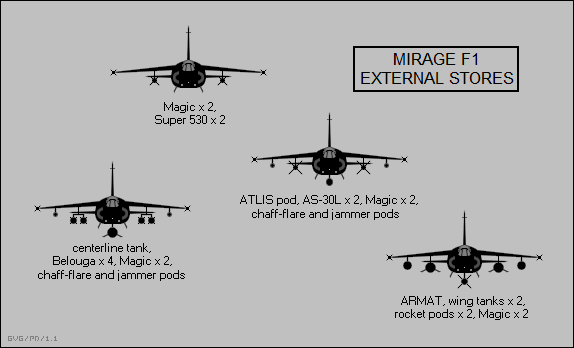
The F1C was designed to be easy to maintain and quick to turn around between sorties. Initially, flight availability rates were unimpressive -- but the bugs were worked out in a few years, and the type acquired a good reputation for reliability. In AA service, the F1C was generally painted in an air superiority color scheme, with dark blue-gray on top and light gray on the bottom. During Africa deployments, the dark blue-gray was traded for a sand / chocolate disruptive pattern on top, retaining the light gray on the bottom.
The Mirage F1 could literally fly rings around the Mirage III, with better maneuverability, 30% shorter take-off run, and 25% slower approach speed. The F1 had 43% more internal fuel capacity and 2.5 tonnes (5,510 pounds) greater maximum take-off weight.
* The Mirage F1CR was generally along the lines of a late configuration F1C-200, with refueling probe, BF RWR, and Martin Baker Mark 10 zero-zero ejection seats fitted from the outset. It featured a hatch with a port under the nose for a panoramic or vertical film camera, and an SAT SCM2400 Super Cyclope infrared linescan (IRLS) imager, fitted into the bottom of the right engine nacelle; one of the DEFA cannon had to be removed to accommodate it. The IRLS could provide real-time imagery to a ground station over a line-of-sight datalink. From 1984, all AA F1CR squadrons were equipped with the transportable SARA (Systeme Aerotransportable de Reconnaissance Aerienne) ground analysis station, consisting of eight shelters.
The Mirage F1CR often carried a Thomson-CSF RAPHAEL-TH (RAdar de Photographie Aerienne ELectrique a Transmission Hertzienne) side-looking airborne radar (SLAR) pod on the centerline pylon, which could also relay real-time data to a ground station. The F1CR was originally fitted with Cyrano IVM radar, which was then upgraded to the Cyrano IVMR variant -- similar to the Cyrano IVM but with enhanced ground attack and low-level navigation capabilities -- and a SAGEM ULISS 47 inertial navigation system (INS). The improved attack and navigation systems gave the F1CR a fairly potent secondary ground attack capability, which the AA would make good use of.
F1CRs were originally flown with a dark green / dark gray disruptive camouflage pattern on top and light gray on the bottom, though for Africa deployments they were repainted with the desert camouflage colors applied to the F1C.

* The Mirage F1B conversion trainer had tandem seats, each under its on rear-hinging clamshell canopy; the fuselage was stretched 30 centimeters (a foot) to accommodate the second cockpit. Fuselage fuel tankage was reduced as well, and cannon armament was deleted, though Dassault CC-420 cannon pods, with a DEFA 30-millimeter cannon and 180 rounds, could in principle be carried on underwing pylons; it was fitted with Cyrano IV radar and the type was regarded as combat-capable. The aircrew sat on Martin-Baker Mark 10 zero-zero ejection seats.
The Mirage F1B did not have midair refueling capability, but it could be fitted with a dummy probe for tanker training. F1Bs seem to have always been painted in the dark blue / light gray air superiority scheme.
* One of the interesting footnotes of the Mirage F1 story was that in the 1970s one was built with the SNECMA M53 afterburning low bypass fan jet, providing 83.4 kN (8,500 kgp / 18,740 lbf) afterburning thrust. Fit of the M53 demanded structural changes, larger inlets, and heftier landing gear. The external appearance was generally the same, though the fuselage was stretched by 23 centimeters (9 inches) and empty weight increased by a little over 8%. The machine was originally designated "Mirage F1E" until that designation was passed off to the export multirole variant (discussed below) and then "Mirage F1.M53". Initial flight of the one-off aircraft was on 22 December 1974.
The Mirage F1.M53 may have originally been simply an engine testbed, but it was seen as a possible contender for a requirement that had been issued by a number of Western European nations to obtain a replacement for the Lockheed F-104 Starfighter, then in widespread service but facing obsolescence. However, this "deal of the century" was snagged by the General Dynamics F-16, and work on a second Mirage F1.M53 prototype, which was to be fitted with full multirole combat avionics kit, was abandoned. The M53 was used in the Dassault Mirage 2000 second-generation delta fighter series.
BACK_TO_TOP* Since Dassault had done such a good export business with the Mirage III/5 series, of course export variants of the Mirage F1 were offered as well. Sales were respectable, but not on the scale enjoyed by the Mirage III/5 series. The Mirage F1 was a good aircraft at an attractive price, but it was followed a bit too quickly by the Dassault Mirage 2000, which was clearly superior in most respects, and so became preferred by customers. Export Mirage F1s included variations on the standard Mirage F1C interceptor and F1B two-seater, as well as the "Mirage F1A" day attack fighter and the "Mirage F1E" multirole aircraft.
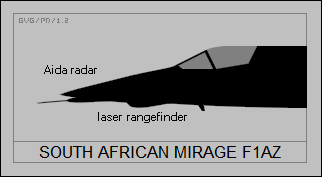
The F1A was intended for sunny tropical climates where weather was rarely any obstacle to flying combat missions. It featured:
Since the F1 had originally been designed as a multirole fighter and was "shoehorned" into AA service as an interceptor, there wasn't much difference between the F1C and the F1E series, except for the enhanced Cyrano IVMR radar fitted to the F1CR reconnaissance variant. In fact, some export users obtained F1Es that were designated F1Cs, and to be even more confusing, some export machines with an F1A designation were F1Es as well. A few users also obtained "F1D" two-seaters that were much like the F1B, but fitted with Cyrano IVMR radar.
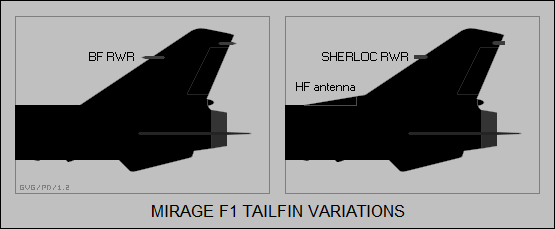
There were generally minor (sometimes not so minor) variations in kit for each user, Dassault adopting a "customer is always right" attitude. For example, Mirage F1s adopted by some users, including Libya and Iraq, had the forward tailfin extension for an HF radio antenna seen on some export versions of the Mirage III/5. Other variations in avionics included the advanced Thomson-CSF SHERLOC digital RWR, with distinctive rectangular antenna fairings on the tailfin.
Export users often obtained reconnaissance pods -- the AA was the only user to obtain a dedicated reconnaissance variant of the Mirage F1, in the form of the F1CR -- including:
A few users obtained the Intertechnique buddy tanker pod, a French-built version of a US Douglas-designed unit, which does not appear to have been used by the AA with the Mirage F1. Of course, while export users often bought French stores like the Magic and Super 530 AAMs, they also used stores from elsewhere, like the US Sidewinder, or their own munitions.
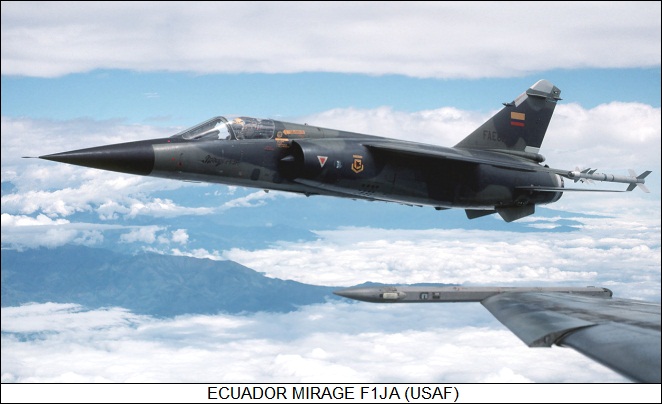
* Export customers included:
* The last Mirage F1s were rolled out in 1990. Many Mirage F1s have received upgrades since then to keep them in service. In 1991, a program was initiated to convert 55 AA Mirage F1C-200 machines into modernized "Mirage F1CT" strike fighters, intended as an interim strike fighter until the delayed Dassault Rafale fighter enters full service. Initial redeliveries were in 1992.
The most noticeable external change of the F1CT fit was of the Thomson-TRT TMV630A laser rangefinder in a small fairing under the nose. The SHERLOC digital RWR was also fitted, and Matra Corail chaff-flare dispensers were attached under the wing roots. Some F1CTs were also fitted with an oblique film camera. Internally, the airframe was refurbished and strengthened, and avionics were updated with a new digital processor, a SAGEM ULISS 47 INS, and a secure radio. The left cannon had to be removed to accommodate the new avionics. The Cyrano IVM radar was to have been updated to the Cyrano IVMR, but apparently this was not done.
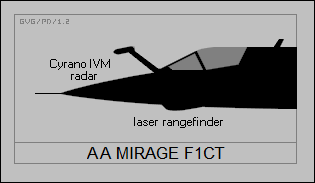
The F1CTs were repainted in an overall dark green / dark gray disruptive camouflage scheme. Some F1C-200s were fitted with Global Positioning System (GPS) navigation satellite receivers in the early 1990s, but this appears to have been a separate program, and it is unclear if the F1CTs had GPS gear.
* AA Mirage F1CRs were similarly given updates in the early 1990s to keep them in service, being fitted with a forward-looking infrared (FLIR) imager in a pod mounted under the left engine nacelle, displacing the remaining DEFA cannon and displaying imagery on a new HUD. Unlike the old IRLS, the FLIR could be viewed in real time by the pilot and could be used for navigation, further enhancing the F1CR's attack capabilities.
Matra Corail chaff-flare dispensers were fitted, and the Thomson-CSF ASTAC (Analyseur de Signal TACtiques) electronic intelligence (ELINT) pod was qualified for centerline carriage. Upgraded RAPHAEL-HT pods, with a modern synthetic aperture radar / moving target indicator (SAR-MTI) system, were introduced as well. Later in the decade, the F1CRs were fitted with the Thomson-CSF Optronics PRESTO (Pod REconnaissance STand Off) pod with a film LOROP camera, which was then upgraded to the DESIRE (DEmonstrateur Simplifie de Reconnaissance Electro-optique) configuration, carrying an electro-optic LOROP camera and a high-speed data recorder.
The numbers of AA F1s began declining since the late 1980s, but thanks to upgrades it lingered well into the next century, the type finally being fully withdrawn in 2014. In 2017, 63 were sold to the US ATAC firm, a subsidiary of Textron Corporation that flies warbirds under military contract for use in aggressor training. A good number of these machines were for use as spares hulks; those put to training service were given modernized avionics, though the Cyrano radar and HUD were not upgraded.
* A total of 53 Spanish F1s -- 49 single-seaters and 4 two-seaters -- were updated by Thomson Detexis to modernized "Mirage F1M" standard, with redeliveries from 1997 to 2001. The upgrade featured:
The upgrades kept the Mirage F1 flying for Spain for a decade more, but that was the end of the matter. The last Mirage F1 in Spanish service were retired in 2013; Argentina contemplated buying 16 of them, but backed out. In 2017, another 22 Spanish Mirage F1s -- 20 single-seat F1Ms, 2 twin-seat F-1BMs -- were sold to Draken International, another US company that flies warbirds under contract to the military. Four AA two-seaters were sold to Paramount Aerospace Systems of South Africa, to be resold to Draken, while Draken also obtained at least five Jordanian Mirage F1s. Paramount updated the F1s not being looted for spares to more modern avionics.
* Sagem and Thales implemented a Mirage F1 upgrade program for Morocco as a step towards a global upgrade offering, as well as resale of Mirage F1s retired from the AA. The Moroccan upgrade program involved 27 machines and featured engine refurbishment & upgrade; modern RDY400 radar; a digital cockpit with HOTAS controls, twin multifunction displays, a new HUD, and a threat warning display; a laser gyro GPS-INS system; a MILSTD-1553B databus; a PAJ-FA self-protection jammer; plus support for the Thales Damocles targeting pod, MICA radar-guided and heat-seeking AAMs, and the AASM smart bomb family.
BACK_TO_TOP* Although sales of the Mirage F1 were modest compared to other Mirage fighter subfamilies, the type seemed to have an inclination to get into scraps, seeing combat with many of the air arms that adopted it. That wasn't an accident by any means: a good proportion of the customers who bought the F1 were engaged in or about to be engaged in conflicts, and some deliveries were expedited so that the aircraft could be rushed into frontline service as fast as possible. In such cases, the customers were often under international arms embargoes -- but the French were not choosy about who bought their weapons, as long as the buyer's credit was good, and were perfectly willing to sell to apartheid South Africa and Saddam Hussein's Iraq.
* The first combat deployment of the AA's Mirage F1s was in 1983 under Operation MANTA, with four SEPECAT Jaguars and four Mirage F1C-200s sent to Chad, which was then fighting a Libyan-backed insurgency. The Jaguars were used for attack while the F1C-200s were used for air cover. One Jaguar was shot down and an F1C-200 damaged in early January 1984. The deployment ended in September 1984, but the AA would be back.
Jaguars and Mirage F1s were redeployed to Africa in 1986, with the number of F1s involved varying over the next few years but reaching a peak of 12 F1C-200s and two F1CRs. The AA took a more aggressive attitude towards the Libyans on this second deployment, launching two strikes on a Libyan-built airfield at Wadi Doum in northern Chad in February 1984. As before, Jaguars were the strike element and the F1C-200s provided air cover, while F1CRs provided pre-strike and post-strike reconnaissance. As is often the case with dirty little wars in the back of beyond, the story remains obscure, but in the end the government of Chad was finally overthrown by rebels in 1992. The French went back home again.
Libyan Air Force Mirage F1s flew missions over northern Chad, but there were never any confrontations between Libyan and AA F1s. The US was having intermittent confrontations with the Libyans during the 1980s, and apparently Libyan Mirage F1s crossed paths with US Navy Grumman F-14 Tomcats on occasions -- but they never shot it out.
* In the meantime, Iraqi Mirage F1EQs were keeping very busy fighting the Iranians during the Iran-Iraq War of the 1980s, with the F1EQs claiming destruction of at least 35 Iranian aircraft, mostly McDonnell F-4 Phantoms and Northrop F-5E Tiger IIs, but also one Grumman F-14 Tomcat, shot down on 22 November 1982. Seven F1EQs were lost in combat, and a number were flown back to France in Iraqi Ilyushin Il-76 transports for repair of extensive battle damage.
In addition, Iraqi F1EQs performed ground attacks on Iranian forces, and launched large numbers of Exocet missiles at tankers steaming in the Persian Gulf. The Exocet proved somewhat disappointing; it was accurate, but lacked the hitting power needed to sink a large tanker, and the maritime "kills" were of small vessels. It could still do quite a bit of damage: on 17 May 1987, in a case of mistaken identity, Iraqi Mirage F1EQs hit the US Navy frigate STARK with two Exocets, killing 37 American sailors. The Iraqis quickly apologized for the action.
* In 1990, Iraq's Saddam Hussein invaded Kuwait, setting off the Gulf War, which ended in the disastrous rout of Iraqi forces in 1991. The Gulf War was the high point of the Mirage F1's combat career, with the type operated by both sides in the conflict. A number of Kuwait's Mirage F1CKs were destroyed in the initial invasion, but 15 escaped, to be painted with "FREE KUWAIT" alongside the nose and flying combat sorties against the Iraqis. Their combat record is unclear, but none were lost in the fighting.
The Iraqi Mirage F1EQs saw a good deal of combat -- on the losing end of the battle. Three F1EQs were shot down by US Air Force (USAF) F-15 Eagles firing AIM-7 Sparrow AAMs on 17 January 1991, with one more lost in an accident while mixing it up with a USAF F-111 Aardvark strike aircraft on the same day. The Mirage F1EQ was the first Iraqi aircraft to be lost in air combat in the war.
Two more F1EQs were shot down by USAF F-15s on 19 January, with another two lost to a single Saudi F-15 on 24 January; there were USAF aircraft that could have been vectored against the two F1EQs, but the decision was made that it would be good for Saudi morale if a Saudi pilot did the job. One final kill on an F1EQ was scored by a USAF F-15 on 27 January. That left the final score of F1EQ versus F-15s as 0:8, not counting the F1EQ lost in an accident. The contest was clearly unequal -- but Iraqi handling of air combat in the conflict was unbelievably timid, and the F1EQs might have done a bit better for themselves with more inspired leadership and piloting.
At least one F1EQ was lost on the ground in an airstrike by British Royal Air Force Tornados on 17 January, being destroyed by a JP233 cluster bomb. At the end of the month, in a move that still remains baffling, most of the Iraqi Air Force, including 24 Mirage F1s, fled to Iran, Iraq's bitter enemy. The Mirage F1s languished in Iranian service -- but a refurbishment and upgrade program named Project HABIBI was begun in 2007 or so, with a number of these machines having been redelivered.
* As far as the AA went, the Mirage F1 was not on the leading edge of the action in the Gulf War. Eight F1C-200s were sent to the United Arab Emirates for enhanced air defense, the duty being performed by three different AA squadrons on a rotational basis. They complemented Qatari Mirage F1EDAs also flying in the air defense role,
None of these machines saw active combat, but four F1CRs were deployed to Saudi Arabia to perform reconnaissance until early 1991, when they were temporarily pulled from combat duty to avoid "fratricide" due to potential confusion with Iraqi F1s. After the initial tsunami of air strikes, the F1CRs returned to combat, using their Cyrano IVMR radar to lead strike packages of Jaguars -- French Jaguars had a relatively unsophisticated nav-attack avionics fit, not in a league with the F1CR's -- while carrying and dropping bombs of their own. The F1CRs then returned to reconnaissance sorties. All the AA Mirage F1s were back home in the spring of 1991. The F1CRs flew 114 combat sorties, more than half of them strike missions, losing one of their number in a fatal accident.
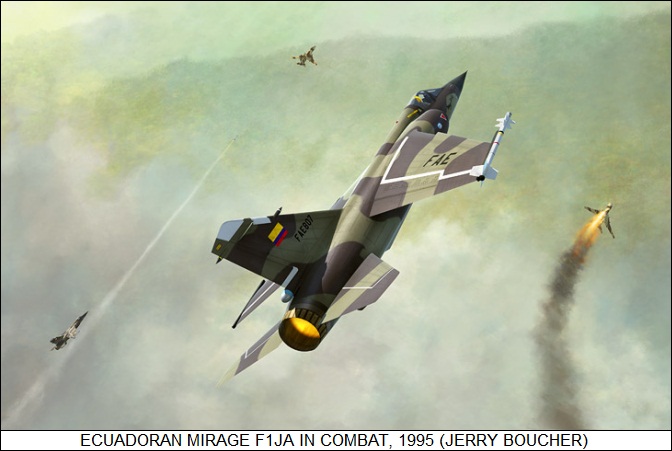
* Other combat action of the Mirage F1 included:
AA F1CRs have been used for reconnaissance operations over Afghanistan, operating from Tajikistan, and both F1CRs and F1CTs performed service in the Wars of the Yugoslav Succession of the 1990s.
BACK_TO_TOP* The Mirage F1 is such a tidy aircraft that it is a bit of a pity that it isn't still being produced: a two-seater with an up-to-date engine and avionics would seem like a very nice, relatively low-cost lead-in fighter trainer, and light strike aircraft. With F1s ending up in civilian hands, hopefully I can see one at a US air show one of these days.
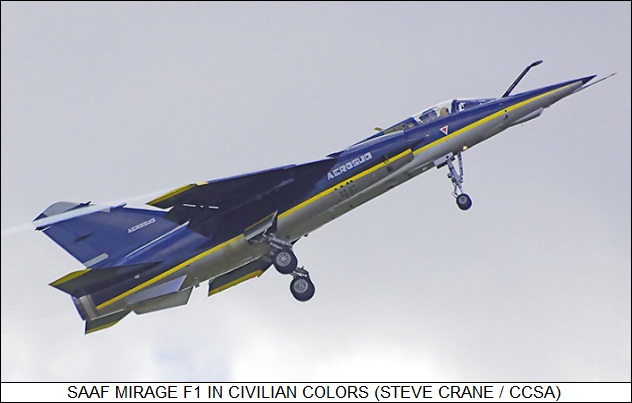
* Sources include:
* Revision history:
v1.0.0 / 01 sep 05 v1.0.1 / 01 apr 07 / Comments on Spanish F1s as per Gorka Martinez. v1.0.2 / 01 apr 09 / Moroccan F1 upgrade program. v1.0.3 / 01 may 10 / Review & polish. v1.0.4 / 01 oct 11 / Review & polish. v1.0.5 / 01 sep 13 / Review & polish. v1.0.6 / 01 aug 15 / Spanish F1 retirement. v1.0.7 / 01 jul 17 / Review & polish. v1.0.8 / 01 jun 19 / Review & polish. v1.0.9 / 01 apr 21 / Review & polish. v1.1.0 / 01 feb 23 / Review & polish. v1.1.1 / 01 feb 25 / Review & polish. (+)BACK_TO_TOP
